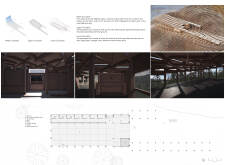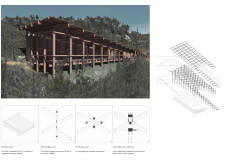5 key facts about this project
Site Integration and Environmental Considerations
The Yoga Temple is elevated on stilts, responding to the contours of the cliff while minimizing disruption to the natural environment. This elevation provides panoramic views of the surrounding landscape, creating a unique atmosphere for practitioners. The design incorporates large windows that allow natural light to fill the interior, blurring the lines between inside and outside spaces. The careful siting of the building emphasizes a connection to nature, fostering a serene environment conducive to yoga practice.
The use of environmental design strategies includes a rainwater collection system that supports sustainable water management for the facility. This feature reduces reliance on external water sources and emphasizes mindfulness regarding resource consumption. The structure's orientation takes advantage of natural light patterns, enhancing energy efficiency while providing a calming ambiance.
Unique Structural and Material Approach
What distinguishes the Yoga Temple from conventional wellness centers is its innovative use of materials and structural techniques. The primary structure is composed of replaceable wooden panels, which align with principles of sustainability and ease of maintenance. This choice of material allows for a warm aesthetic while minimizing environmental impact through responsible sourcing.
Furthermore, the joints used in the wooden framework display advanced engineering techniques that facilitate modular assembly and disassembly. This adaptability encourages longevity and efficiency in repairs, supporting the overall sustainability ethos of the project. The antiseptic properties of the selected wood contribute to a healthy indoor environment, crucial for maintaining cleanliness in a space designed for physical activity.
Programmatic Design Features
The Yoga Temple offers dual spaces for practice: an elevated open area suitable for advanced practitioners and a semi-enclosed lower level accommodating novices. This layout enables flexibility in programming and addresses the varying needs of participants. The fluid circulation design also encourages movement throughout the space, reflecting the dynamic nature of yoga practice.
In conclusion, the architectural design of the Yoga Temple serves as a model for integrating wellness practices with environmental stewardship. Its thoughtful design details, materials, and spatial configurations create a functional and inviting space for yoga practitioners. To gain deeper insights into the architectural plans, sections, designs, and ideas underlying this project, readers are encouraged to explore the presentation further.


























